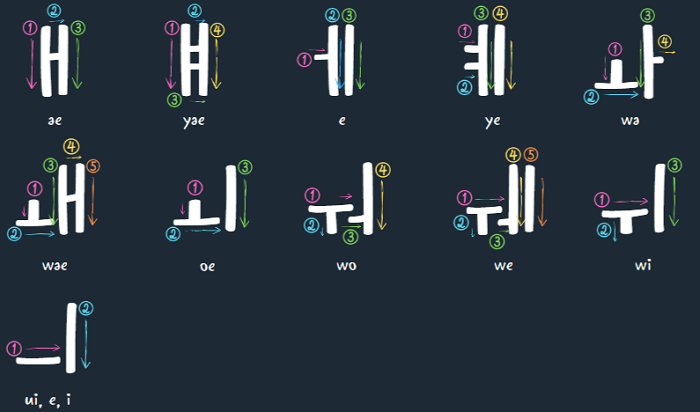Double Vowels in Korean
The Korean text pronunciation feature (🔊) is only available for Chrome, Edge, Safari, and Opera browsers.
11 Double Vowels
The following set of letters represents the final 11 out of the 40 letters that you must learn to be able to read any Korean word. Compared to the other letters, these letters typically require more time to master since some of them are similar not only in spelling but also in pronunciation. Thus, these letters are more likely to be challenging to recall. However, do not worry, as with some practice, you will quickly improve. You can also use flashcards at the end of this lesson, to help you memorize the letters.
ㅐ
ae
ㅒ
yae
ㅔ
e
ㅖ
ye
ㅘ
wa
ㅙ
wae
ㅚ
oe
ㅝ
wo
ㅞ
we
ㅟ
wi
ㅢ
ui, e, i
Here we have slightly changed the order of the vowels to make it easier for you to memorize them.
Move your mouse over a letter to see how it's written or click on it to learn how to pronounce it.
ae | e
ㅐ
ㅔ
yae | ye
ㅒ
ㅖ
wa
ㅘ
wo
ㅝ
wi
ㅟ
ui, e, i
ㅢ
wae | we | oe
ㅙ
ㅞ
ㅚ
* "ㅢ" can also be pronounced as " e " and " i ". (Click on these words: 의사, 나의, 희망)
🔊 (Click on a letter to hear its sound.)
In modern Korean, there is no distinction in pronunciation between ㅐ and ㅔ, ㅒ and ㅖ, ㅙ and ㅞ. However, these letters are not interchangeable and it is important to know which letter to use in different situations. Similar to English, some letters may be used to represent the same sound.
For example, cell and sell.
Rules of writing Korean letters
See how to write 11 double Korean vowels.
There are two rules that are not mandatory, but it is recommended to follow when writing Korean letters.
1. Horizontal strokes should go from left to right →
2. Vertical strokes should go from top to bottom ↓

Exercises
Quick reference (click to open)
Vowels: a, e, i, o, u
Consonants: b, c, d, f, g, h, j
Syllable: Bra-zil (2 syllables), Ar-gen-ti-na (4), In-di-a (3), Viet-nam (2), thin-king (2), beau-ti-ful (3), good (1)
Batchim: is a final consonant in a syllable. → Bra-zil (batchim: 'l'), Ar-gen-ti-na (batchims: 'r' and 'n'), In-di-a ('n'), Viet-nam ('t', 'm')
Romanization: is a conversion of text (not pronunciation ! ) from different writing system (Korean, Arabic, Russian, etc.) to the Roman (Latin) alphabet.
IPA: is an alphabetic system of phonetic (pronunciation) notation.
Noun: road, user, sister, table, sky
Pronoun: I, my, we, you, they, her
Verb: to go, to study, to think, to feel
Adjective: cold, kind, hungry, curious, expensive
Adverb: quickly, nicely, never, exactly, urgently
Preposition: from, to, on, in, with, till
Conjuction: and, because, if, but, while
Declarative sentence: I learn Korean.
Interrogative sentence: Do you learn Korean?
Imperative sentence: You must learn Korean!
Exclamative sentence: Wow, you learn Korean!
Verb / Adj. stem in Korean: part of a verb or adj. which is left after removing the last syllable -다 ( e.g. 가다 → 가, 예쁘다 → 예쁘, 듣다 → 듣 ).




